Pistons 1-2-2 match-up
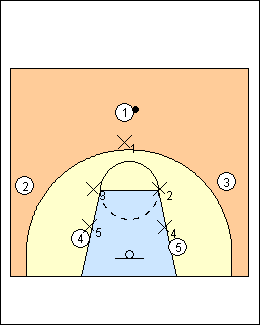 | 1 Flip Saunders Detroit Pistons Is basically a switching man-to-man defence that has one defender on the ball and four defenders close to the paint, including two helpers with the ball (6 eyes on the ball). Rules - don't leave the dribbler except when attackers cross, ballscreen or dribble hand-off (switch) - deny dribble and pass penetration into the paint (do not deny non-penetrating passes) - play the 3-point line, encourage the ball to the corners or out top, nothing to the house - contest every shot, no layups, no 2nd shots - force cutters to go behind, switch all cutters - never turn your back on the ball, stay in a help position - front or 3/4 the low post. There is good defensive rebounding because everyone has man responsibility. The Pistons try to keep bigs in and guards out. |
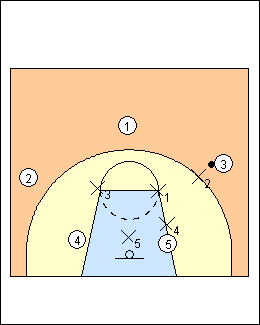 | 2 Match-ups - X1 is the boss, match up off him - the other four defender start with one foot in the paint, inside hand up - X2 is always one man (attacker) to X1's right - X3 is one man to X1's left - X4 is one man to X2's right; if there is no attacker in the corner he goes to the low block, then high post, then other block - X5 is one man to X3's left, he has the same rules as X4 - the farther your man from the ball, the flatter the ball-you-man triangle - give help, but make sure you contest the shot (less help if slower or to take away a 3-pointer). Here if 3 moves down to the right corner, X2 still has him. Hoop Tactics - Match-Up Zone - X5 takes the center, or if there is no post takes the baseline player to X1's right. |
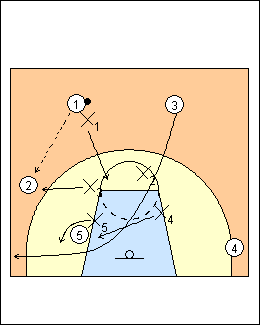 | 3 Against a one-guard attack, 1 calls and takes the ball. Against a two-guard front, X1 takes the attacker on the left. Force the ballhandler sideline. Cuts A cutter going behind is a kick-back situation; a cutter going in front is a kick-down situation. a) Strong-side cut X2 calls "cutter" and makes 3 go behind him, driving 3 to kick-off or switch X4, and X2 now has 4. As 3 and 5 cross, X4 and X5 switch (except on Shaq), X5 goes over 5. If instead 4 runs the baseline, X4 and X5 switch when 4 and 5 cross (an easier cut to handle). Chris Oliver - 32 Match-Up - X1 is always responsible for the ball against the initial offensive alignment. Know your close-out constantly, that's the match-up component. |
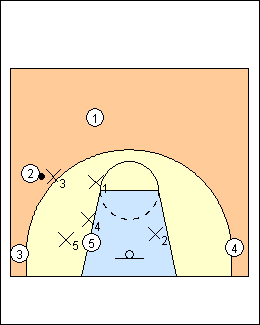 | 4 X5 does not rush out on 3. In a man or zone defence, when the ball is on the wing there should be defenders at the ballside block and elbow ("early fill"). |
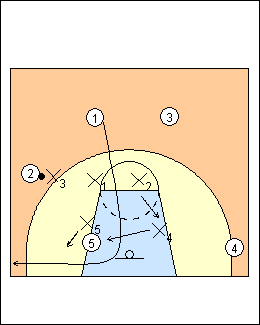 | 5 Here 1 cuts up the middle then to the ballside corner. X1 calls "cutter", X4 picks him up, then switches with X5 as 1 and 5 cross. |
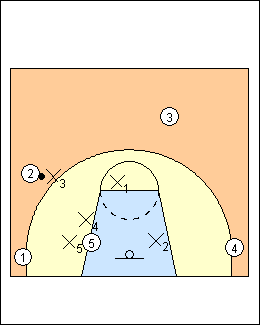 | 6 X1 matches up off the ball and takes 3, X2 has 4. |
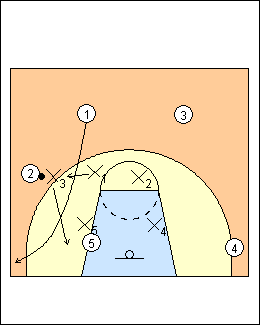 | 7 A cutter who cuts in front of you is a switch (kick-down) situation. Here 1 cuts in front of X1 to the ballside corner, X3 and X1 switch. Call "home" to get back into the 1-2-2 set when defenders are confused. However, 9 times out of 10, when an attacker leaves your area, another attacker will come in, and defenders should always be communicating who's got ball and the other attackers. The Pistons don't foul much because they sag a lot in help positions. "Scarecrow" - sometimes when the Pistons are playing man-to-man defence, their defenders will stand with locked knees and hands straight up, making it look like a zone defence |
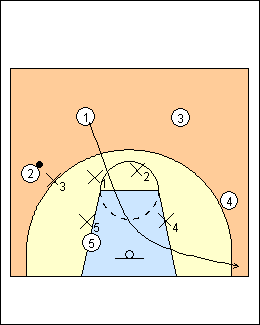 | 8 b) Weakside cut 1 cuts to the weakside corner. |
 | 9 X1 takes 3, X2 takes 4, and X4 takes 1. If 4 and 1 exchange on the weakside, X2 and X4 stay put and switch their match-ups. It's an automatic dig by X3 on a pass to low-post 5. |
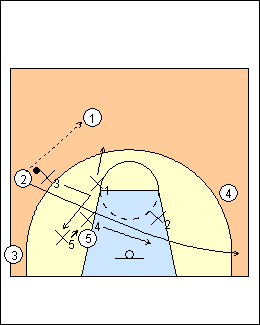 | 10 Overloads 2 passes to 1 and cuts to the weakside corner. X1 closes out on the pass, X3 sags to the elbow. When 2 cuts, X3 takes 3 (one attacker to 1's left), X4 takes the cutter, and X5 takes 5. If instead 3 runs the baseline on the pass to 1, X4 and X5 switch. Defenders close out with inside hand high, the other hand below the knee, which makes sure the knees are bent. If a big with the ball on the perimeter is being defended by a guard, body up to him, make him turn his back, cut off half the court. The 1-2-2 match-up gives you the ability to defend 3-point shots. |
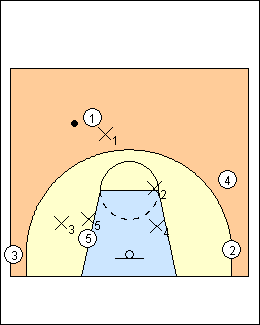 | 11 Match-ups. |
 | 12 If 2 passes to 3, X3 sags and X5 closes out; when 2 cuts weakside, X3 calls "kick" and goes out to take the ball, tapping X5, who takes 5. X4 takes the cutter. |
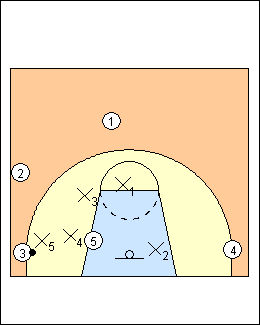 | Overload situation with the ball in the corner (2 has not cut weakside). X2 has dropped to basket level because 4 is in the deep weakside corner. (Note that X3 does not deny a pass out of the corner) |
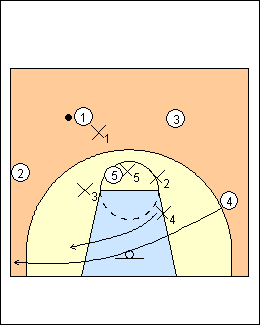 | 14 X4 and X5 are on a buddy system. However, when there is a big at the high post, defenders stay matched up. Here 4 cuts through and X4 stays with him, there is no switch with X5, who is defending 5 at the high post. If instead 3 were to make the cut, X2 would kick him back to X4 who takes him all the way, X2 takes 4. |
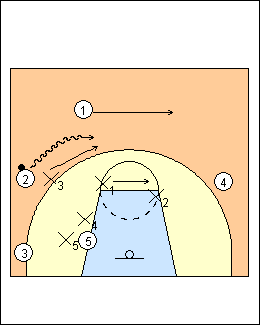 | 15 Dribble-Outs X3 stays with 2 if he dribbles out around the perimeter and doesn't cross with other attackers. Defenders switch on a dribble hand-off, or if the dribbler crosses with another attacker. |
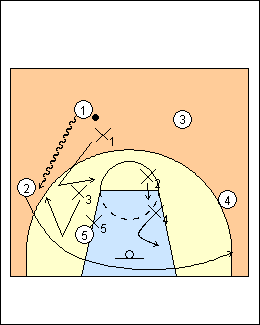 | 16 Here 1 dribbles out 2 to the weakside. When 2 cuts through, X3 will stunt and chase back, taking the ball, and kicking X1 to 3 and X2 to 4. X4 takes the cutter. Don't worry too much about cutters going away from the basket, you should be able to rotate to them. |
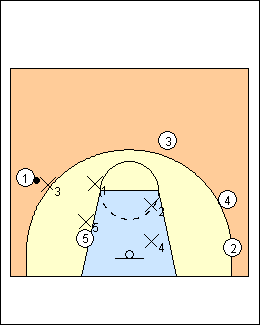 | 17 Match-ups. |
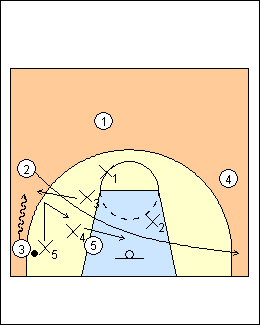 | 18 Here 3 dribbles out of the corner, clearing 2 to the weakside. X3 takes the ball when 2 cuts through, X5 switches, then X4 takes the cutter and X5 takes 5. If 2 instead came back to the ballside corner, X5 would take him, and X4 stay with 5. |
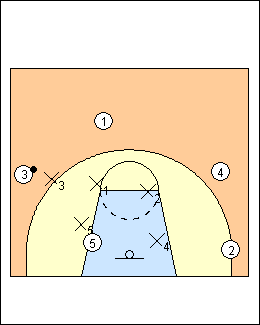 | 19 Match-ups. |
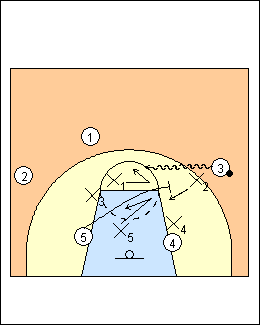 | 20 Pick and Roll Defending a pick and roll, X5 comes up with 5, then X1 takes 5 and X5 kicks back taking O2 and X3 takes O1. X1 takes 3 as he comes off the screen, X2 takes the screener. The Pistons want X1 to take anyone going into a pick and roll, then switch. However, if X1 is too far away from the play, X5 will sag off to protect the basket, and X2 will fight over the screen if 3 is a shooter, or under it otherwise. Against Dirk Nowitski they will have to switch. The main job of a big switching out is not to get beat off penetration, he can contest a shot. On a step-up ballscreen from the baseline, the Pistons switch. |
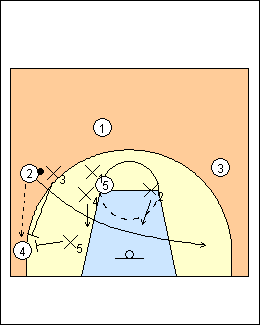 | 21 With the ball on the wing, X1 drops as deep as the ball but can't pinned by high post 5 on a skip pass. X1 is the "jam" guy, open to the ball with his left hand in the passing lane to 5 and his left leg over top of 5's right leg. Oliver - the high post is covered by the weakside post. They don't deny it, they don't mind if it goes there for a challenged 15-footer. Trapping (55) When the Pistons are having trouble with overloads, they will trap the left corner hard on the pass with X5 and X3, their bigger trappers. They do not trap the right corner, but after the first trap many opposing coaches will tell their players to keep the ball out of both corners. |
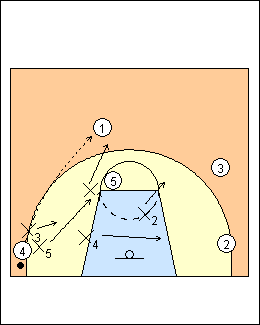 | 22 When X3 and X5 trap, X4 covers the low block, X1 takes the elbow, and X2 protects the basket from lobs. On a pass out of the trap to 1, X1 takes the ball, X3 stays with O4 (one man to 1's left), the other defenders rotate to their match-ups. Bigs always come out over the top of attackers. Playing against the Phoenix Suns, the Pistons want to score and make the Suns take the ball out of the net. They never help off the corner, the bigs are the help. On offence, take Nash to the baseline when he is defending, get him further from the other basket on the fast break; also, be shot disciplined to make the Suns play defence. The Pistons offence has to stop the Suns, so the Suns can't create their offence from the Pistons offence. |
This page was made with Basketball playbook from Jes-Soft